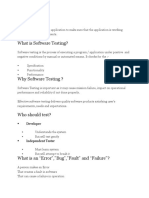0% found this document useful (0 votes)
10 views8 pagesIntroduction To Software Testing
Software testing is essential in software development to ensure quality and performance by identifying defects before release. It encompasses various types, including manual and automated testing, and follows a structured lifecycle with key phases for effective defect management. Utilizing common testing tools enhances the process, leading to improved software quality and user satisfaction.
Uploaded by
peddigarivamshiCopyright
© © All Rights Reserved
We take content rights seriously. If you suspect this is your content, claim it here.
Available Formats
Download as PPTX, PDF, TXT or read online on Scribd
0% found this document useful (0 votes)
10 views8 pagesIntroduction To Software Testing
Software testing is essential in software development to ensure quality and performance by identifying defects before release. It encompasses various types, including manual and automated testing, and follows a structured lifecycle with key phases for effective defect management. Utilizing common testing tools enhances the process, leading to improved software quality and user satisfaction.
Uploaded by
peddigarivamshiCopyright
© © All Rights Reserved
We take content rights seriously. If you suspect this is your content, claim it here.
Available Formats
Download as PPTX, PDF, TXT or read online on Scribd
/ 8























































